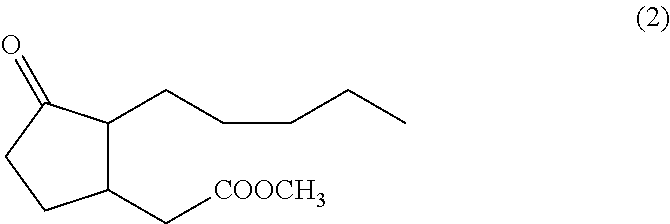Methods of reducing leaf senescence using methyl dihydrojasmonate
a technology of methyl dihydrojasmonate and leaf senescence, which is applied in the field of plant biology, can solve the problems of reducing the success of crop establishment, survival and performance, affecting the perceived health and commercial value of plants or crops, and affecting the survival of crops, etc., and achieves the effect of reducing leaf senescen
- Summary
- Abstract
- Description
- Claims
- Application Information
AI Technical Summary
Benefits of technology
Problems solved by technology
Method used
Image
Examples
example 1
Foliar MDHJ Treatment Reduces Senescence in Miniature Roses
[0038]Potted miniature PARADE® roses were evaluated for the effect on leaf senescence of foliar spray treatment with an MDHJ formulation. One group of four plants acted as an untreated control group and did not receive any foliar spray. Another group of four plants was sprayed with a formulation comprising 1.5 mM MDHJ, 0.5% TRITON® X-100, and 0.125% canola oil. The treated plants were sprayed on six occasions, on days 1, 3, 12, 29, 31, and 58, by spraying foliage to the point of drip. The number of leaflets exhibiting senescence was analyzed 65 days after the first treatment. Senescence was indicated by chlorosis and necrosis affecting greater than 50% of an individual leaflet.
[0039]The results of Example 1 are shown in Table 2. Specifically, MDHJ treatment reduced leaf senescence normally associated with the end of the growing season. Sixty-five days after treatment, MDHJ-treated roses showed no senescing leaves, while untr...
example 2
Foliar MDHJ Treatment Reduces Senescence in Yellow Dwarf Rose
[0041]Potted Yellow Dwarf roses were grouped into one of four groups, and each of the groups received one treatment. The four groups are set forth in Table 3 below. One group was an untreated control (UTC), while the other three groups were treated with aqueous solutions of MDHJ that differed only in the concentration of MDHJ. There were three plants in each group. Before the trial began, naturally senescing leaves were visible on all plants; these were removed at the time that the trial began. The rose leaves received one foliar spray treatment by applying spray until the point of drip. Evaluation for leaf senescence, without any additional treatment, occurred on days 3, 7, 10, 14, and 31 by counting the number of leaves on each plant exhibiting senescence. Senescence was indicated by chlorosis and necrosis affecting greater than 50% of an individual leaf. After each evaluation, senescing leaves were removed.
[0042]
TABLE 3...
example 3
MDHJ Treatment Reduces Senescence in Spinach
[0045]Greenhouse-grown spinach seedlings, cultivar ‘Merlo Nero,’ were divided into two groups, with eight plants per group. One group was left untreated, while the other group was treated with 0.5 mM MDHJ in 0.1% ethanol by spraying leaves until the point of drip. Treatments occurred on days 1, 4 and 8 of the experiment. On day 6, senescence was noted on some leaves, defined by chlorosis and / or necrosis. Senescence began at the leaf tip and spread towards the petiole. On day 8, the number of plants exhibiting senescence was counted. All leaves from each plant were then harvested and combined for each treatment. The total number of senescing leaves were counted and taken as a percentage of the total number of leaves per treatment. Senescence was indicated by chlorosis and necrosis affecting greater than 50% of an individual leaf.
[0046]In the untreated spinach group, 87.5% of the plants exhibited signs of senescence compared to 37.5% in the ...
PUM
 Login to View More
Login to View More Abstract
Description
Claims
Application Information
 Login to View More
Login to View More - R&D
- Intellectual Property
- Life Sciences
- Materials
- Tech Scout
- Unparalleled Data Quality
- Higher Quality Content
- 60% Fewer Hallucinations
Browse by: Latest US Patents, China's latest patents, Technical Efficacy Thesaurus, Application Domain, Technology Topic, Popular Technical Reports.
© 2025 PatSnap. All rights reserved.Legal|Privacy policy|Modern Slavery Act Transparency Statement|Sitemap|About US| Contact US: help@patsnap.com



